To ensure the accuracy of the color of plastic bottle silk screen printing, you can start from the following aspects:
First, equipment and materials
Ink selection
Understand the compatibility of plastic bottle materials: Different plastic bottle materials (such as PET, PE, PP, etc.) have different adsorption properties for ink. For example, the surface of PET plastic bottles is smooth, and it is necessary to choose a strong adhesion ink, like UV ink on PET bottles can have a better performance. Because UV ink curing speed is fast, you can form a strong ink film in a short time, and bright color, high saturation.
Ensure that the ink batch is consistent: If the screen printing work of the same product is carried out in batches, ensure that the ink is the same batch. Because different batches of ink may have slight differences in color, this is due to raw material composition, production process and other factors. When purchasing ink, it is necessary to clearly require the consistency of color to the supplier, and keep ink samples for comparison.
Screen selection and maintenance
Mesh size suitability: mesh size affects the amount of ink transfer and printing accuracy. For fine patterns requiring higher color accuracy, a higher mesh should be selected. For example, when printing a pattern with a gradual effect or small font, use a screen of about 300-350 mesh, which can make the ink evenly through the screen to ensure the uniformity and accuracy of the color.
Screen tension stability: the tension of the screen should be stable. If the screen tension is insufficient, the screen is easy to deform during the printing process, resulting in uneven ink transfer and color deviation. The tension meter can be used to periodically detect the mesh tension, and the general mesh tension is more appropriate between 18-22N /cm. And when installing the wire mesh, ensure that it is evenly stretched.
Screen cleaning: After each printing is completed, the screen should be cleaned in time. When the residual ink dries, it will clog the mesh, affecting the amount of ink transmission for the next printing. You can use a special screen cleaning agent, soak the screen in the cleaning agent for a period of time, and then gently brush the mesh with a soft brush, and finally rinse with water and dry.
Printing equipment calibration
Scraper adjustment: The Angle, pressure and hardness of the scraper have an important impact on color accuracy. The Angle of the scraper is generally between 60-70 degrees, and the Angle is too small to make the ink not clean, resulting in darker color; If the Angle is too large, the ink transfer amount is insufficient, and the color becomes lighter. The pressure of the scraper should be moderate, too much pressure may damage the screen, and too little pressure is insufficient ink transfer. For plastic bottles with higher hardness, you can use a slightly higher hardness scraper, such as a scraper with 70-80 Shore hardness, to ensure that the ink can be evenly transferred to the bottle.
Flatness of the printing platform: The printing platform must be kept flat. If the platform is not flat, the plastic bottle will be tilted or partially suspended when placed on it, resulting in uneven pressure during printing, which will affect the accuracy of the color. A level can be used to regularly check the flatness of the printing platform, and ensure that the levelness of the platform is within the allowed error range during the installation and commissioning of the equipment.
Second, the printing process
Color blending
Use a color matching system: Use a professional color matching system, such as PANTONE. The Pantone Color card offers a wide range of standard color samples, which can be blended to match the color card through precise formulations. When mixing colors, the paste or ink base color should be accurately added according to the formula ratio on the color card, and the color should be fully mixed during the mixing process.
Make color samples: Before the official printing, make a small area of color samples for testing. Screen printing can be done on the test piece of the same material as the plastic bottle, and then the test piece is compared with the color standard required by the design. If there is a deviation, adjust the ink formula in time until the color sample and the standard color reach a satisfactory match.
Printing parameter control
Stable printing speed: Maintain a stable printing speed during the printing process. Too fast speed will make the ink on the surface of the plastic bottle adhesion time is too short, resulting in ink can not fully fill the pattern, the color becomes lighter; If the speed is too slow, the ink will accumulate and the color will become darker. Generally according to the drying speed of the ink, the material of the plastic bottle and the complexity of the pattern to determine the appropriate printing speed, for example, when using UV ink to print a simple pattern of PET plastic bottles, the printing speed can be controlled at 1-2 meters/minute.
Ink drying conditions control: Different ink has different drying methods and requirements. For solvent-based inks, the drying temperature and ventilation conditions should be controlled. Excessive temperature may cause ink discoloration or surface crusting, affecting the adhesion and color accuracy of the next layer of ink. For UV ink, ensure that the power and irradiation time of the UV lamp are appropriate. If the UV lamp power is insufficient or the irradiation time is too short, the ink can not be fully cured, and the color will change; Too high power or too long irradiation time may make the ink yellow, affecting the color accuracy.
Third, quality testing and control
Color detection tool used
Spectrophotometer: Use a spectrophotometer to detect screen color. A spectrophotometer can accurately measure the spectral reflectance or transmittance of a color and compare the measurement results with data for a standard color. For example, in the CIE Lab color space, the L (brightness), a (red-green axis), b (yellow-blue axis) values of the color can be accurately measured, and the difference between the silk screen color and the standard color can be judged by comparing the △E value (color difference value). Generally, the △E value is less than 1.5 to ensure the accuracy of the color.
Standard light source box: When detecting color, it should be carried out in the standard light source box. Because different light sources (such as daylight, fluorescent lamps, tungsten lamps, etc.) will make the color look different. The standard light source box can provide a variety of standard light sources, such as D65 (simulated daylight), F11 (cold white fluorescent lamp), etc., to ensure that the color evaluation of the plastic bottle after screen printing is carried out under uniform light source conditions.
Process monitoring and adjustment
First piece inspection: After each startup printing or replacement of ink, screen and other key materials, the first piece inspection should be carried out. A comprehensive color inspection of the first printed plastic bottle, including comparison with standard color cards, measurement with a spectrophotometer, etc. If the first color does not meet the requirements, immediately stop printing, adjust the printing parameters, ink, etc., until the first color is qualified.
Regular sampling: In the process of batch printing, regular sampling should be carried out. Generally every a certain number of plastic bottles (such as every 50-100) is extracted for color inspection. If the color deviation is found, adjust the printing equipment and process parameters in time, and evaluate the printed product to determine whether it needs to be reworked.
How to ensure the color accuracy of plastic bottle silk screen printing?
Nov 25, 2024Leave a message
Send Inquiry
















